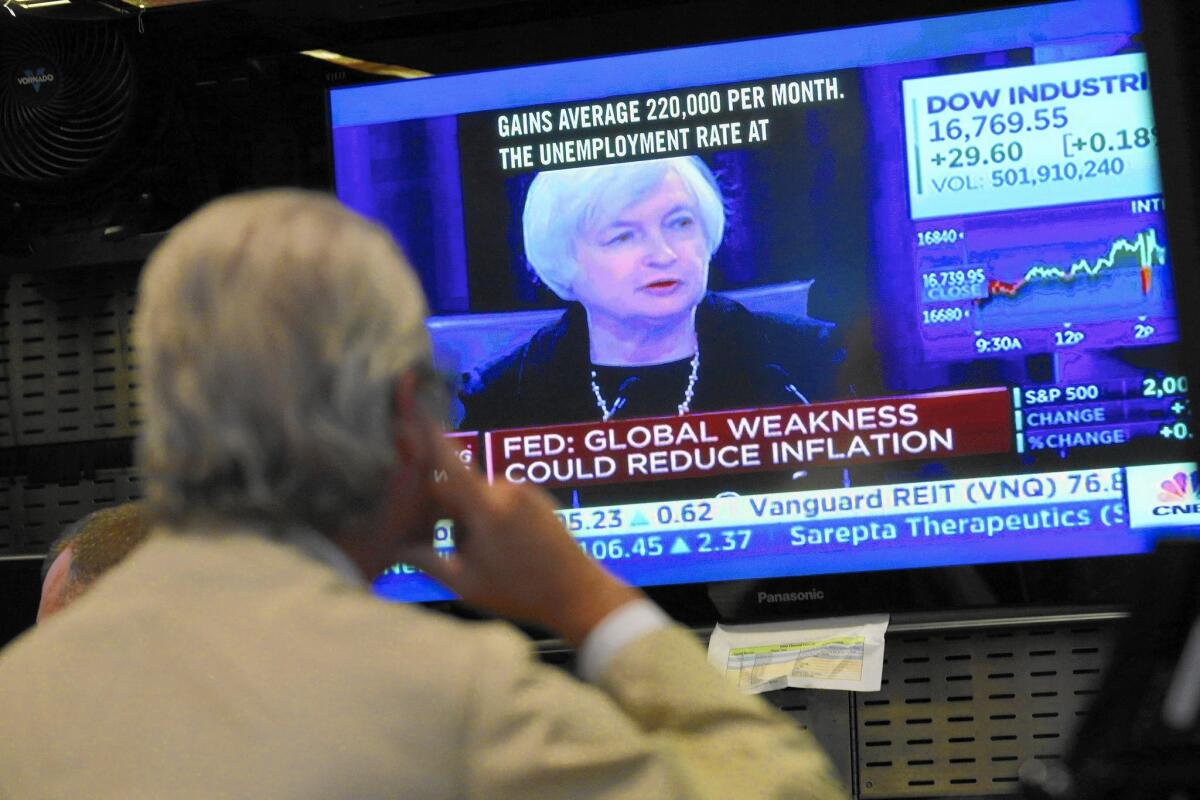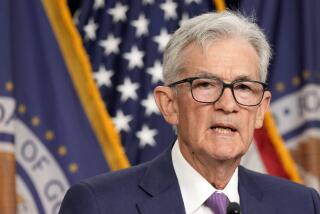Fed holds interest rates steady

- Share via
reporting from washington — Cautious Federal Reserve officials, spooked by a slowing Chinese economy and turbulent markets, delayed a long-awaited interest rate increase and, in the process, heightened the uncertainty engulfing financial and business communities worldwide.
Most Fed officials still see a rate increase later this year. But their policy statement Thursday cited worries that global economic and financial developments could “restrain economic activity,” and Fed Chairwoman Janet L. Yellen said she and her colleagues wanted “a little bit more time to evaluate the likely impacts on the United States.”
But Yellen also took pains to convey the message that the economic fundamentals and outlook for the U.S. remained solid and had not changed. The U.S. economy “has been performing well and impressing us by the pace at which it is creating jobs,” she said.
The mixed signals left investors and analysts uncertain about how they should regard the state of the economy and when the Fed might make its first rate increase in nine years.
“The market’s hopelessly confused,” said Chris Rupkey, chief financial economist at the Bank of Tokyo-Mitsubishi in New York.
He had just watched the Dow Jones industrial average soar nearly 200 points and then fall 100 points into the red as Yellen explained the policymakers’ rationale to reporters during a televised news conference.
“The lack of action leaves lingering uncertainty about the outlook for U.S. policymaking, which will no doubt fuel further volatility in the markets,” Rupkey said.
The so-called federal funds rate, a benchmark for consumer and business loans, has been held near zero since late 2008 to help boost the economy during and after the Great Recession.
The rate will remain at the unprecedented low level at least until late next month, continuing an easy-money policy that has helped the labor market recover and boosted stock prices while hurting senior citizens and others on fixed incomes who rely on interest income.
Although policymakers said that the U.S. economy has improved and that “solid job gains” have been posted recently, they expressed concerns that inflation remains very low and that a slowdown in the global economy could push it further down.
Very low inflation — driven recently by the sharp drop in oil prices — is a drag on workers’ incomes and could hold back U.S. economic growth. Inflation has been running at about half the central bank’s 2% annual target, and depressed commodity prices and cheaper imports, stemming partly from China’s slowdown, have added more downward pressure on inflation.
The recent Chinese stock market crash and sudden currency devaluation by Beijing have sparked fears that the slowdown may be more abrupt and severe than experts had thought. China, the world’s second-largest economy, is a leading driver of global trade and demand for commodities
With little hard data on the effects of the recent turmoil on the U.S., the Fed opted to wait.
Their policy statement, approved by a 9-1 vote, surprised experts, not so much in the decision not to act but in their reluctance to give a stronger indication of imminent action.
“At the end of the day, I did not think they would move; but I thought that they would signal that a move was perhaps closer than it had been before,” said Carl R. Tannenbaum, executive vice president and chief economist at Northern Trust in Chicago.
“But the language in the statement around international developments seems to reveal a state of concern that’s going to really weigh on the group as they proceed through the remainder of the year,” he said.
Yellen, however, was more upbeat during an hourlong news conference, adding to the confusion and sending the Dow on a roller coaster ride. It closed down 65.21 points, or about 0.4%, at 16,674.74. Yellen warned against reading too much into the Fed’s hesitation to act this month, suggesting a rate increase could come as soon as October.
“Of course, there will always be uncertainty. We can’t expect that uncertainty to be fully resolved,” Yellen said.
In what may be a case in point, she warned about the possible effects of a looming federal government shutdown if Congress and the White House can’t agree on a budget by the end of the month.
“We have a good recovery in place that’s really making progress and to see Congress take actions that would endanger that progress, I think that would be more than unfortunate,” she said.
But Fed policymakers are taking risks by waiting as well.
“With each month that it holds off from pulling the trigger, the costs could be greater, since financial market volatility may increase prior to each meeting until the central bank actually goes ahead with a rate hike,” according to a note by Moody’s Analytics, an economic forecasting firm.
At the same time, Yellen and her colleagues have been under pressure not to act from liberals who argue there still are not enough good-paying jobs for low- and middle-income workers.
There was high anticipation that the Fed would announce a small increase of 0.25 percentage point after a two-day meeting.
Organizations such as the World Bank warned the Fed to hold off. Others in the U.S. and abroad argued that the U.S. economy was strong enough to get off the Fed’s extraordinary support and that a rate increase would shore up confidence.
On Thursday, about 50 protesters from Fed Up, a coalition of labor, community and liberal activist groups, marched outside the building where Yellen held her news conference. They chanted “Keep rates low, let our wages grow” and “Keep rates zero, be our hero.”
After the Fed’s announcement, Rep. Maxine Waters (D-Los Angeles) praised Fed officials for choosing “to exercise a prudent and cautious approach to safeguarding our economy.”
Yellen noted Fed policymakers “have been receiving advice from a large number of economists and interested groups,” but made the decision based on their analysis of the economy.
“We’re well aware that there’s been a huge focus on the decision,” she said, “and I would ask you to appreciate that there are a lot of cross-currents in economic and financial developments that we need to take into account in deciding what the appropriate course of policy is.”
Fed officials slightly upgraded their projections for economic growth this year to 2.1% from a 1.9% estimate in June.
But they downgraded their projections somewhat for economic growth for the next two years to 2.3% next year and 2.2% in 2017, continuing the sluggish pace that has marked the recovery from the Great Recession.
The unemployment rate is forecast to drop to 5% by the end of the year, much better than the 5.5% that Fed policymakers projected in June.
It was 5.1% in August and is forecast to fall to 4.8% by the end of next year.
But inflation will remain even lower than forecast in June. Fed officials projected it would be just 0.4% this year and not hit the central bank’s annual 2% target until 2018 — a year later than they expected in June.
More to Read
Inside the business of entertainment
The Wide Shot brings you news, analysis and insights on everything from streaming wars to production — and what it all means for the future.
You may occasionally receive promotional content from the Los Angeles Times.












